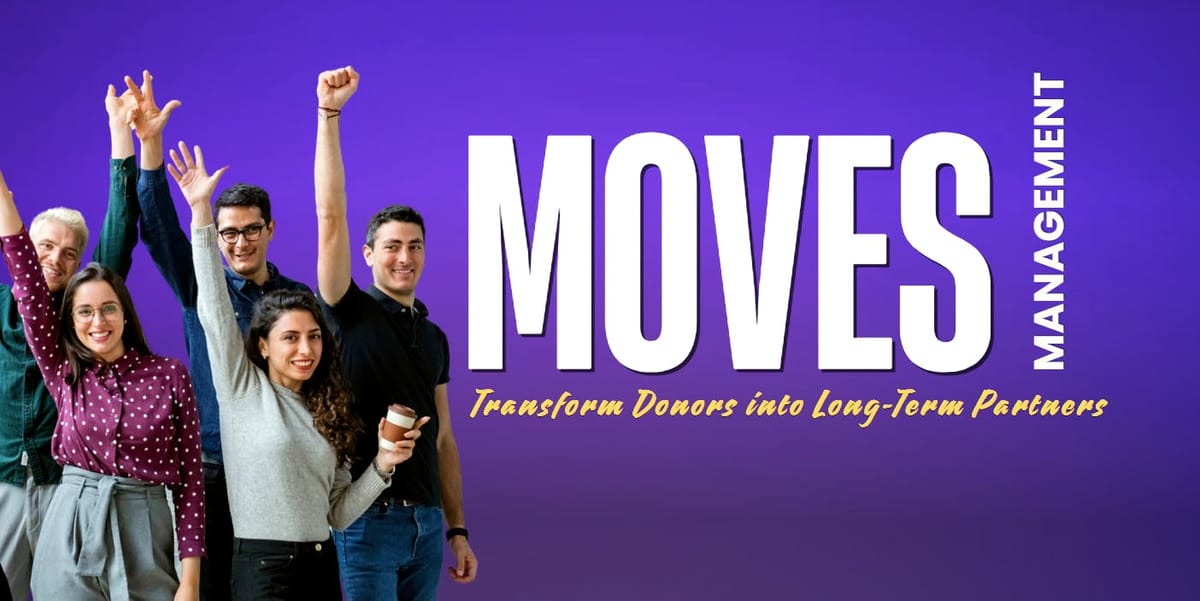Implementing a Moves Management Strategy in Your Donor Relations
Discover how moves management can enhance donor relations and drive fundraising success with personalized strategies and data-driven insights.

Moves management is a systematic approach to donor engagement that can significantly boost your nonprofit's fundraising efforts. Here's what you need to know:
- Definition: A roadmap for building stronger donor relationships over time
- Key components: Donor tracking, planned interactions, and strategic "moves" to increase support
- Benefits: Improved donor retention, larger gifts, and personalized donor experiences
Related video from YouTube
How to implement moves management:
- Group donors based on giving history and potential
- Set specific goals for each donor segment
- Plan engagement activities ("moves") for each group
- Track all donor interactions and outcomes
- Regularly review and adjust your strategy
Key metrics to track:
| Metric | Purpose |
|---|---|
| Donor retention rate | Measure loyalty |
| Upgrade rate | Track increased giving |
| Engagement score | Assess interaction levels |
| Major gift conversion | Monitor high-value donor growth |
Moves management transforms your approach from random outreach to a data-driven, personalized donor journey. By focusing on building relationships and showing impact, you can significantly improve your fundraising results.
The basics of moves management
Moves management is a game-changer for nonprofits. Here's why:
Main parts
- Donor stages: From prospect to major donor
- Personalization: Tailoring interactions
- Data tracking: Recording touchpoints
- Action planning: Mapping next steps
- Goal setting: Defining donor objectives
How it helps nonprofits
Moves management isn't just talk - it gets results:
- Higher retention: Only 35% of donors stick around yearly. Moves management can change that.
- Bigger gifts: Nurture relationships, get more support.
- Stronger connections: Donors feel valued, not just like ATMs.
How it's different from older methods
| Old Approach | Moves Management |
|---|---|
| One-size-fits-all | Personalized journeys |
| Random outreach | Planned touchpoints |
| Transaction focus | Relationship focus |
| Reactive | Proactive |
| Limited data use | Data-driven decisions |
Moves management takes donor relations from shotgun to sniper rifle. It's "Hey Sarah, remember that project?" instead of "Dear Donor."
"Moves management is about treating donors as individuals and building real relationships over time." - Meredith Gray, Head of Marketing, Keela
Getting ready to use moves management
Let's prep for moves management:
Look at your current approach
Take a hard look at your donor relations:
- How do you track interactions?
- What's your follow-up process?
- How do you segment donors?
Use this to find gaps and areas to improve.
Choose who's involved
Moves management isn't solo work. Your team might include:
- Development staff
- Marketing team
- Board members
- Program managers
"Bring your development team into donor management. And don't forget marketing folks." - Fundraising Consultant
Set clear goals
Don't guess. Use SMART goals:
| Criteria | Example |
|---|---|
| Specific | Boost major donor retention by 15% |
| Measurable | Track retention rate monthly |
| Achievable | Current rate: 70% |
| Relevant | Fits overall fundraising strategy |
| Time-bound | Hit goal in 12 months |
Your goals should link to key metrics that matter to your org.
How to put moves management into action
Ready to implement your moves management strategy? Here's how:
Group your donors
Create donor profiles and group them based on:
- Giving history
- Engagement level
- Interests and motivations
- Capacity to give
Use research tools to gather this info. The Animal Protective Association of Missouri used social media to group supporters interested in dog adoptions, helping them tailor their outreach.
Make a plan
Create a timeline with specific actions for each donor group. Assign team roles:
| Timeline | Action | Team Member |
|---|---|---|
| Month 1 | Send personalized emails to high-capacity donors | Development Director |
| Month 2 | Host small group event for mid-level donors | Events Coordinator |
| Month 3 | Launch social media campaign for new supporters | Marketing Manager |
Build relationships with donors
Use personalized communication to build trust:
- Send handwritten notes
- Invite donors to behind-the-scenes tours
- Share impact stories related to their interests
Ask for donations
Plan your asks based on donor interests and ability to give. For major donors, consider one-on-one meetings.
"Moves management isn't about swindling people or wheeling and dealing to squeeze money out of them. Rather, it's about looking at a cohort of donors and communicating the immense additional good that can be done with a little more." - CharityEngine
Thank and update donors
Develop a strategy for thanking donors and showing impact:
- Personalized thank-you videos
- Impact reports
- Exclusive updates on supported projects
Checking if it's working
To make sure your moves management strategy is doing its job, you need to keep an eye on some key numbers and tweak things as you go. Here's the deal:
What to measure
Zero in on these metrics to see if your moves management is hitting the mark:
| Metric | What it means |
|---|---|
| Donor retention rate | How many donors come back for more |
| Upgrade rate | How many donors up their game |
| Engagement score | How much donors interact with you |
| Major gift conversion | How many donors become big-time givers |
Fun fact: The average donor retention rate in nonprofits is about 35% (Fundraising Report Card, 2023). Your moves management should aim to beat that.
Using donor software
A solid CRM is your best friend for tracking donor interactions. It helps you:
- Build detailed donor profiles
- Log every "move" and how donors react
- Plan your next moves
When picking software, make sure it lets you easily record communication details and track progress with each donor.
Review and adjust
Regular check-ins keep your moves management on point:
1. Team huddles
Get your team together monthly to chat about what's working and what's not. For example:
"Those personalized impact reports? They bumped our major donor retention by 15% last quarter. Let's roll that out to everyone giving over $1,000."
2. Donor portfolio deep dives
Use your CRM to pull reports on each donor's status. Review these often to plan your next steps.
3. Stay flexible
Don't be scared to switch things up. Top organizations make a 10% change even when things are smooth sailing, and a 30% change when they're gunning for big improvements.
Solving common problems
Implementing moves management isn't always smooth sailing. Let's tackle some typical hurdles:
When people resist change
Staff might push back against new processes. Here's how to get your team on board:
- Get everyone involved: Bring gift processors, development officers, and researchers into the decision-making process. It's a surefire way to build buy-in.
- Set clear targets: Establish concrete metrics. For instance, aim to boost donor retention by 10% in year one.
- Train, train, train: Run workshops on the new CRM system and donor engagement best practices.
Meeting donor expectations
Donors want to feel valued and see their impact. Keep them happy by:
- Staying in touch: Create a communication schedule. Think monthly impact reports or quarterly calls.
- Showing results: Demonstrate how donations make a difference. Send a video of your program director thanking top supporters and highlighting recent wins.
- Getting personal: Use your CRM's donor profiles to tailor communications. Mention past conversations or specific interests.
Staying consistent
Keeping up with moves management long-term can be tough. Stay on track by:
- Making an action plan: Create a detailed timeline for donor engagement. For example:
| Month | Action |
|---|---|
| January | Send annual impact report |
| April | Host donor appreciation event |
| July | Conduct mid-year check-in calls |
| October | Launch year-end giving campaign |
- Embracing tech: Use your CRM to automate reminders and track interactions. Set alerts for key donor milestones or giving anniversaries.
- Checking in regularly: Hold monthly team meetings to review progress and tweak strategies. Discuss what's working and what needs a rethink.
Tips for success
Want your moves management to work better? Focus on these key areas:
Make it personal
Tailor your approach to each donor. Use your database to track preferences and giving history. Then:
- Send thank-yous mentioning the donor's name, gift amount, and impact
- Create donor segments based on giving levels or interests
- Use preferred names in all communications
Habitat for Humanity of Pinellas and West Pasco Counties has a webpage for donor stories. This shows donors they're valued as individuals, not just wallets.
Work together across teams
Break down silos for a unified donor approach:
- Form a donor stewardship team with clear roles
- Share donor info across departments
- Meet regularly to discuss engagement strategies
A cohesive team ensures donors get consistent, thoughtful communication at every touchpoint.
Keep learning and improving
Check and refine your process regularly:
- Set measurable goals (e.g., boost donor retention by 10% in 6 months)
- Ask donors for feedback through surveys or chats
- Review strategies monthly and adjust based on results
| Action | Frequency | Metric |
|---|---|---|
| Donor survey | Quarterly | Response rate, satisfaction score |
| Strategy review | Monthly | Donor retention rate, average gift size |
| Team check-in | Weekly | Number of donor touchpoints |
Wrap-up
Moves management can supercharge your nonprofit's donor relations and fundraising. It breaks down the donor journey into clear steps, helping you nurture relationships and boost giving over time.
Here's the gist:
- Segment donors by giving history and potential
- Create custom engagement plans for each group
- Use a CRM to track interactions and progress
- Review and tweak your strategy often
The endgame? Move donors up the giving ladder while building strong relationships. It works - organizations using this approach often see better donor retention and more major gifts.
Take Windfall's wealth screening tools. Nonprofits using them saw a 30% bump in donations from matched affluent donors in just one year. That's the power of focusing on the right prospects and tailoring your approach.
Ready to dive in?
- Pick one donor segment to start with
- Set a specific goal (like "Boost major gifts by 15% in 6 months")
- Check in with your team regularly to track progress
| Action | How Often | Why |
|---|---|---|
| Review donor segments | Every 3 months | Keep donor groups up-to-date |
| Reach out personally | Monthly | Connect with each major donor prospect |
| Evaluate strategy | Twice a year | See how moves management affects retention and giving |
FAQs
How to cultivate a donor?
Want to boost your fundraising? Here's a simple donor cultivation plan:
- Pick up the phone
- Meet face-to-face
- Keep them in the loop via email
- Show them behind the scenes
This approach? It's all about building solid relationships with potential big-time donors.
What are the 5 stages of moves management?
Moves management has 5 key stages:
| Stage | What it means |
|---|---|
| Identification | Spot potential donors |
| Qualification | Check if they can and want to give |
| Cultivation | Get to know them |
| Solicitation | Pop the question (for donations) |
| Stewardship | Say thanks and keep them involved |
What is a donor engagement strategy?
A donor engagement strategy? It's about linking donors' values to your nonprofit's mission. The focus? Building personal connections that lead to ongoing support. The endgame? Showing donors how their money makes a real difference in your work.
What is moves management for major donors?
For major donors, moves management is a 6-step dance:
- Choose your target audience
- Decide what you're asking for
- Set your goals
- Make your plan
- Ask and keep track
- Fine-tune for the long haul
This method helps nonprofits tailor their approach to each big donor. The result? Better chances of landing those large gifts.

